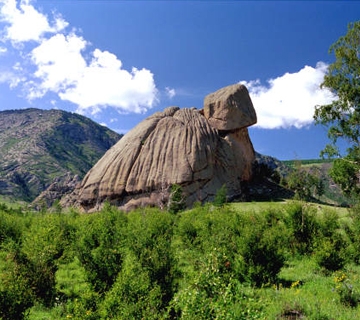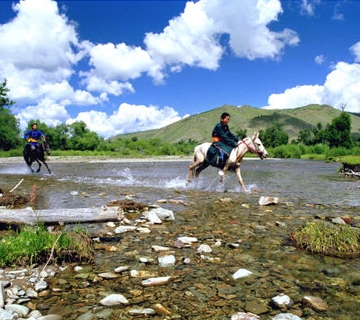You are here: Home » Mongolia » Introduction to Mongolia
|
Photos
 Mongolian wonderful narute  Mongolian lengendary horse  Mongolian boy
|
ClimateMongolia has an extreme continental climate with long, cold winters and short summers, during which most precipitation falls. The country averages 257 cloudless days a year, and it is usually at the center of a region of high atmospheric pressure. Precipitation is highest in the north, which averages 20 to 35 centimeters per year, and lowest in the south, which receives 10 to 20 centimeters.Average temperatures over most of the country are below freezing from November through March and are about freezing in April and October. January and February averages of -20°C are common, with winter nights of -40°C occurring most years. Summer extremes reach as high as 38°C in the southern Gobi region and 33°C in Ulaanbaatar. Most of Mongolia is covered by discontinuous permafrost (grading to continuous at high altitudes), which makes construction, road building, and mining difficult. All rivers and freshwater lakes freeze over in the winter, and smaller streams commonly freeze to the bottom. Ulan Bator lies at 1,351 meters above sea level in the valley of the Tuul River. Located in the relatively well-watered north, it receives an annual average of 31 centimeters of precipitation, almost all of which falls in July and in August.
Ulaanbaatar has an average annual temperature of -2.9°C and a frost-free period extending on the average from mid-June to late August.
Mongolia's weather is characterized by extreme variability and short-term unpredictability in the summer, and the multiyear averages conceal wide variations in precipitation, dates of frosts, and occurrences of blizzards and spring dust storms. Such weather poses severe challenges to human and livestock survival. Official statistics list less than 1 % of the country as arable, 8 to 10 % as forest, and the rest as pasture or desert. Grain, mostly wheat, is grown in the valleys of the Selenge river system in the north, but yields fluctuate widely and unpredictably as a result of the amount and the timing of rain and the dates of killing frosts. Although winters are generally cold and clear, there are occasional blizzards that do not deposit much snow but cover the grasses with enough snow and ice to make grazing impossible, killing off tens of thousands of sheep or cattle. In the winter of 2009-2010 already more than 1 million heads of livestock have been lost due to a severe zuud. Such losses of livestock, which are an inevitable and, in a sense, normal consequence of the climate, have made it difficult for planned increases in livestock numbers to be achieved. Snowstorms can occur as late as June and as early as September in Mongolia. Since Mongolia lacks most of the necessary machinery, streets in winter are usually frozen with a mixture of ice and snow that is sometimes 2-5 cm thick. On the main streets, this leads to continuous accidents. Furthermore, the climate conditions further limit economic activity in the construction sector to only 5 months, since low temperatures pose a threat to the curing of construction materials.
|
General info
|





